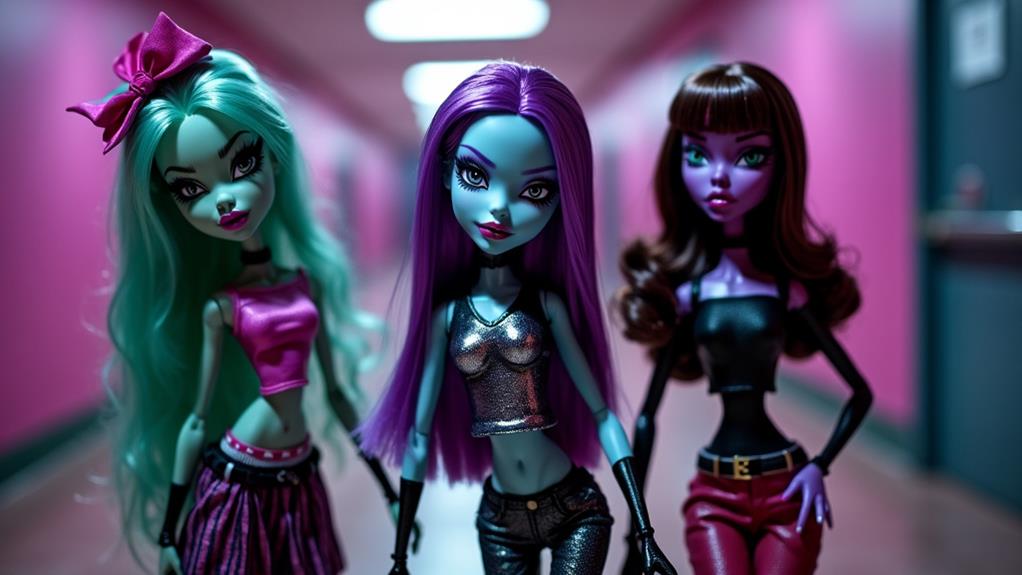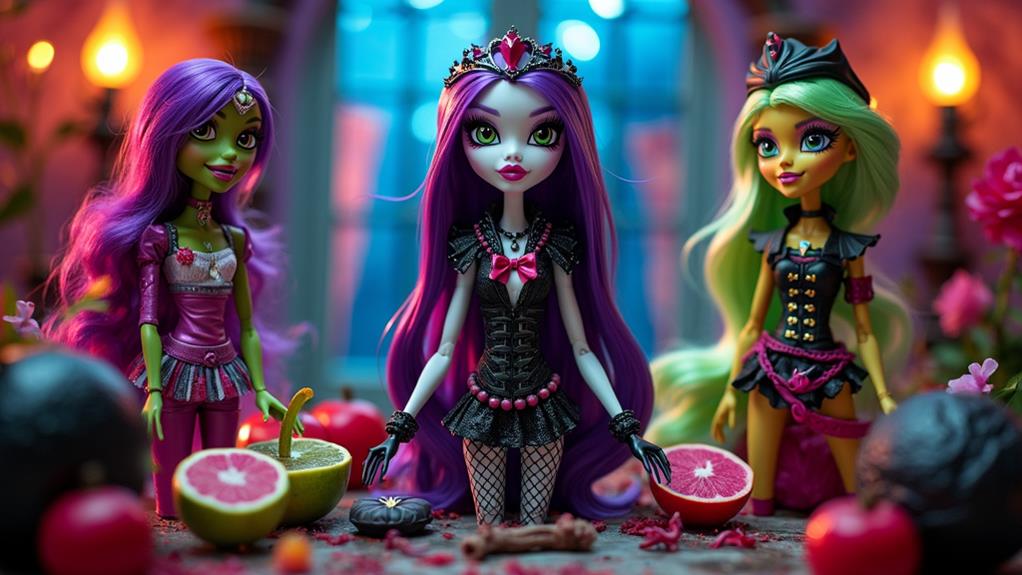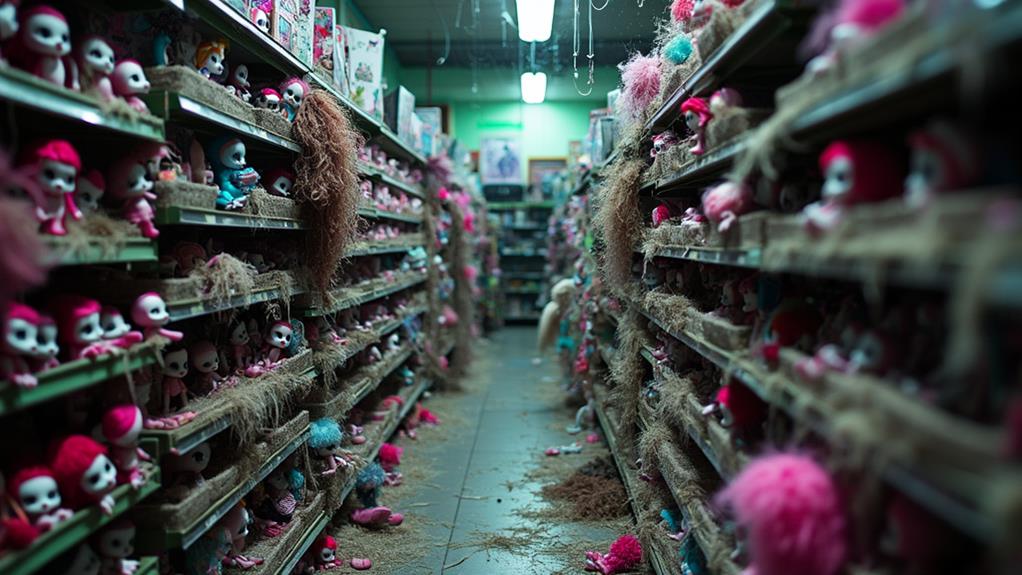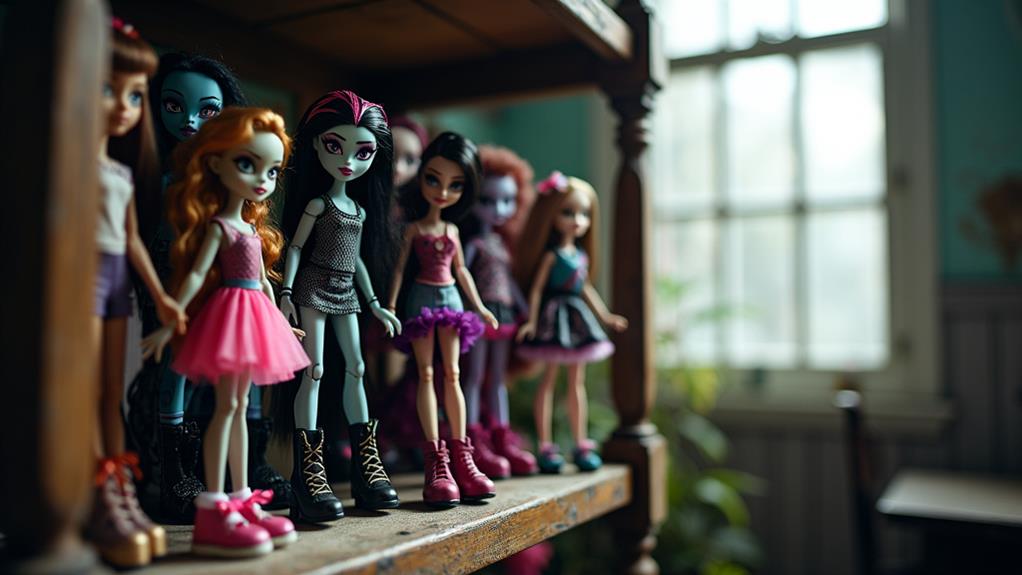Why Did They Change Monster High so Much?
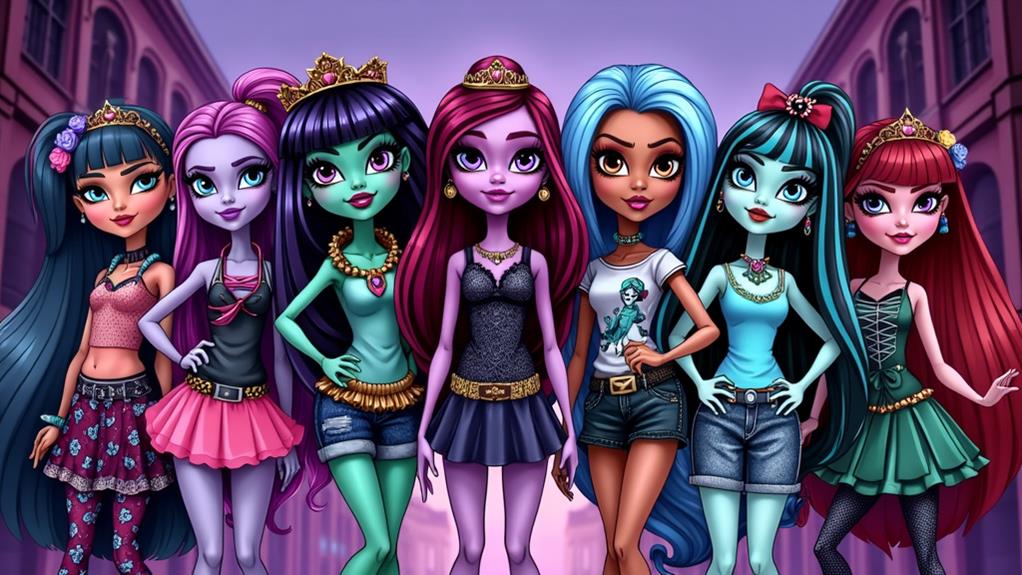
They've changed Monster High noticeably to keep it engaging for both new and old fans. By modernizing character designs and storylines, the brand reflects current societal values and tastes. They've focused on inclusivity, updating core messages to be more relevant. Adding complex narratives and diverse character arcs helps connect with a broader audience. The shift to digital media aims to meet tech-savvy audience demands. Feedback from focus groups guided these changes to resonate with fans while staying competitive in the market. Curious about the strategic decisions and fan reactions behind these updates? There's more to uncover about Monster High's evolution.
Rebranding for a New Generation
Monster High's rebranding aimed to captivate a new generation of fans who crave fresh and modern content. If you were an original fan, you probably remember the excitement of seeing those unique characters for the initial time. But times change, and so do audiences. The rebranding focuses on harnessing the nostalgia factor while ensuring it has generational appeal.
You might wonder why they didn't just stick to the old formula. The truth is, kids today have different tastes and expectations. By updating storylines and themes, Monster High stays relevant and engaging for today's youth. You'll find familiar elements that harken back to the original series, giving older fans that comforting sense of nostalgia.
But it's not just about looking back. The rebranding also aims to resonate with new viewers who may have never seen the original series. This dual approach makes Monster High a hit with both old and new fans alike. So, when you watch the latest episodes or see updated dolls, you're experiencing a blend of the past and the present, crafted to appeal across generations.
Modernizing Character Designs
Updating character designs is a fundamental part of keeping Monster High relevant in the current market. You might notice the characters have undergone significant changes from their original appearances. This character evolution isn't just about making them look different; it's about aligning them with contemporary design aesthetics and trends.
When you look at the new designs, you can see how they've incorporated modern fashion and cultural influences. These updates make the characters more relatable to today's kids, who are exposed to a broader range of styles and media. The lively colors, varied textures, and detailed accessories are all part of this evolution, guaranteeing that Monster High remains visually appealing.
Moreover, the evolution of these characters helps in maintaining the brand's unique identity while also making it fresh and exciting. The new designs often include subtle nods to the original looks, keeping a sense of continuity that long-time fans appreciate. By modernizing character designs, Monster High guarantees that it stays ahead of the curve, capturing the imaginations of both new and returning fans. This careful balance of tradition and innovation is vital for the brand's enduring success.
Updating Storylines
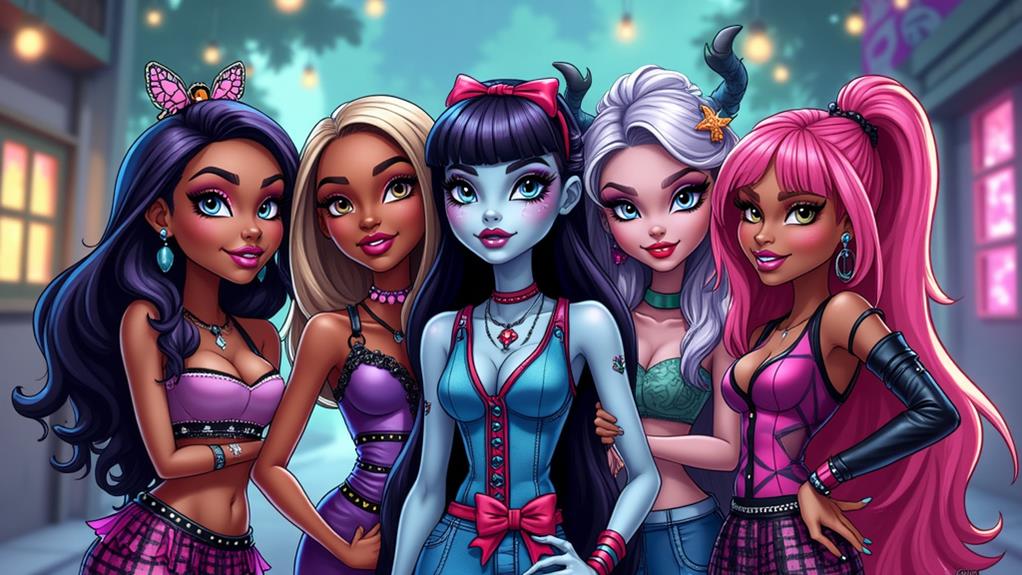
To keep up with ever-changing audience preferences, the storyline updates play a crucial role in Monster High's evolution. You've likely noticed that the series has shifted from simple plotlines to more intricate narratives. This change isn't accidental; it's designed to improve character development and add narrative depth.
By weaving complex backstories and multifaceted personalities into the characters, Monster High makes them more relatable and engaging. You get to see them face real-world issues, from social pressures to personal growth. This approach not only captures your attention but also connects on a deeper emotional level.
Updating storylines allows the series to grow with its audience. As fans mature, they crave more sophisticated content. By addressing these needs, Monster High guarantees it stays relevant and appealing. You'll find that the characters' experiences become more layered, offering lessons and experiences that reflect real-life challenges.
Shifting Core Messages
As Monster High continues to evolve, it's clear that the core messages have shifted to better align with the values of a modern audience. You've probably noticed that the series now focuses more on acceptance, individuality, and self-expression. These changes aren't random; they reflect significant cultural shifts and changing audience expectations.
In recent years, there's been a stronger societal push toward embracing diversity and understanding different perspectives. Monster High's original messages centered around being different and unique, but the new direction amplifies these themes with a fresh, more inclusive approach. The creators understand that today's audience expects more than just entertainment; they want meaningful content that connects with their values and experiences.
Moreover, younger viewers are more socially aware and demand stories that reflect their worldviews. You can see this in how Monster High now tackles issues like body positivity and mental health, which were less prominent before. By shifting its core messages, Monster High speaks directly to these evolving cultural norms, ensuring it remains relevant and impactful. This strategic alignment with contemporary values not only enriches the narrative but also strengthens the bond between the franchise and its audience.
Expanding Inclusivity
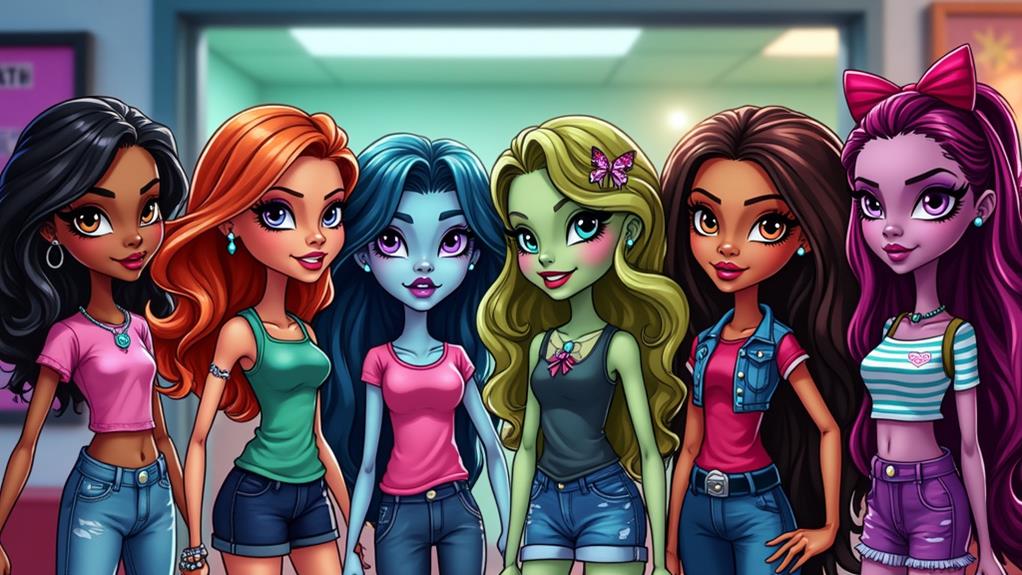
Building on the shift in core messages, Monster High's expansion of inclusivity marks another significant change. The creators recognized the importance of varied representation and cultural sensitivity in the current world. By broadening the range of characters, they aimed to reflect a more inclusive society where everyone can see themselves represented.
You might have noticed new characters from different ethnic backgrounds and with differing abilities. This change wasn't just about adding more faces; it was about ensuring each character had a rich backstory that respects and honors their culture. For instance, rather than relying on stereotypes, the creators consulted cultural experts to portray these characters accurately.
Here's how you can appreciate this evolution:
- Explore the new characters: Immerse yourself in their backgrounds and stories to see how they reflect diverse experiences.
- Notice the cultural details: Observe how Monster High incorporates elements from multiple cultures sensitively and respectfully.
- Share with others: Encourage friends and family to check out the new, inclusive Monster High to foster a greater appreciation for diversity.
Market Trends and Competition
How do market trends and competition shape the evolution of beloved franchises like Monster High? When you look at the recent changes, it's clear that market dynamics play an essential role. As consumer preferences shift, brands must adapt to stay relevant. For Monster High, this meant updating character designs and storylines to reflect current trends and societal values. You might notice that newer characters are more diverse, embracing a wider range of backgrounds and identities. This isn't just about inclusivity; it's about responding to what the market wants.
But it's not just trends that drive change. The competitive landscape is similarly influential. Monster High competes with other major toy brands and entertainment franchises, all vying for the same audience. To stay ahead, they need to offer something unique and engaging. By modernizing their approach, Monster High aims to capture the attention of today's kids while retaining the loyalty of long-time fans.
In essence, the franchise's evolution is a strategic response to both market trends and competition. It's about staying relevant in a fast-paced world where consumer interests and the competitive landscape are constantly developing.
Feedback From Focus Groups
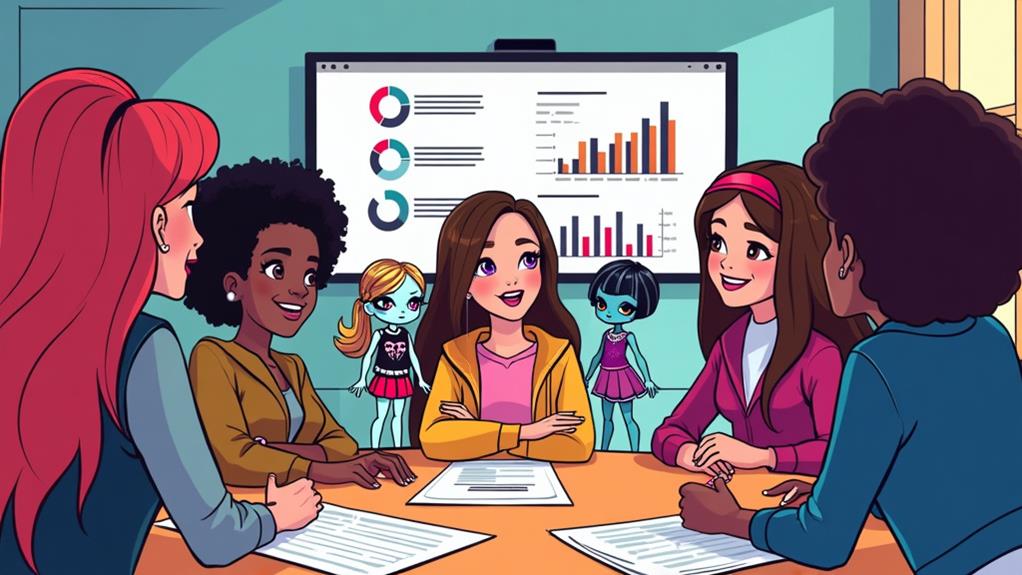
Focus groups play an essential role in shaping the evolution of franchises like Monster High. When you gather a diverse group of individuals to discuss their thoughts and preferences, you get invaluable insights into consumer behavior. These sessions help brands understand what works and what doesn't, leading to more effective changes.
In these focus group dynamics, participants might express preferences for certain character designs, storylines, or even the types of products they want to see. This feedback is gold for companies looking to stay relevant and appealing. For Monster High, these focus groups revealed a few key things:
- Character Appeal: Certain characters were more popular and relatable, prompting a shift in character focus and development.
- Storyline Preferences: Fans wanted richer, more engaging storylines, leading to deeper narratives and more complex character arcs.
- Product Desires: There was a strong desire for more diverse and inclusive products, reflecting the changing demographics and values of the consumer base.
Embracing Digital Media
In the current digitally-driven world, Monster High had to adopt digital media to stay connected with its tech-savvy audience. You've probably noticed how much time kids and teens spend online these days. To keep up, Monster High plunged into digital storytelling, creating fresh, engaging content that lives on diverse platforms.
They've harnessed the power of social media to reach you where you're already spending your time. By sharing exciting stories, character updates, and interactive content on platforms like Instagram, YouTube, and TikTok, they've made sure you're always in the loop. These platforms allow you to engage directly with your favorite characters and storylines, making the Monster High experience more engaging than ever.
Digital storytelling also means you get content in bite-sized, easily digestible formats. Regardless of whether it's short clips, webisodes, or live streams, Monster High is consistently delivering new and exciting ways to keep you entertained. They've successfully shifted from traditional media to a more dynamic, interactive presence online. This change not only keeps you engaged but also helps build a lively, active community of fans who can share and create their own content. In doing so, Monster High has evolved to meet the digital era head-on.
Merchandise and Licensing Changes
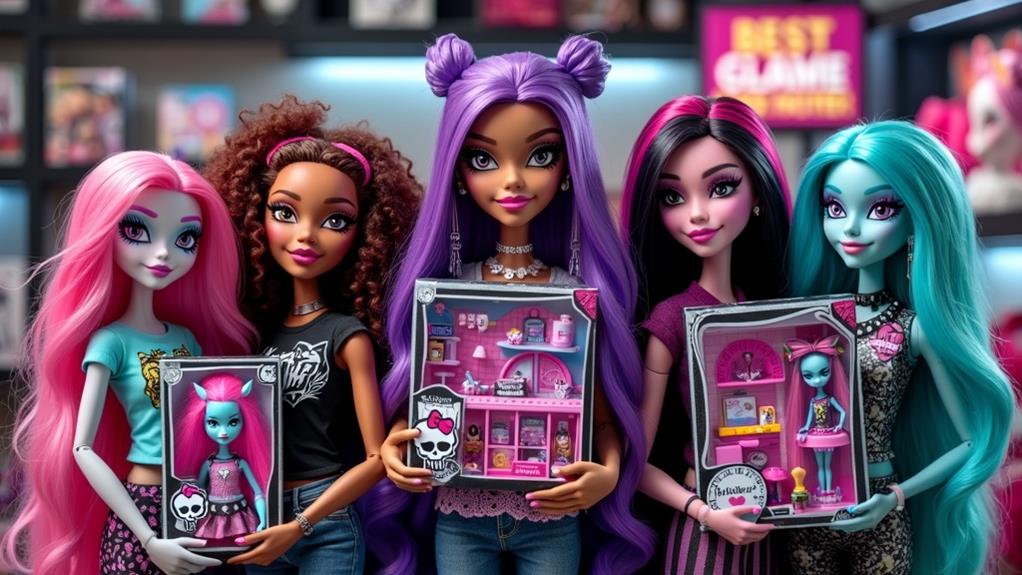
While Monster High has adeptly embraced digital media to engage with its audience, another significant area of change lies in its merchandise and licensing strategies. You've probably noticed the notable shift in the style and range of products available. This merchandise evolution is part of Mattel's broader strategy to infuse new life into the brand, ensuring it stays relevant in a highly competitive market.
Monster High's licensing strategies have also undergone a transformation. Instead of limiting their focus to traditional dolls, they've expanded their horizons to include a wide variety of merchandise. This includes fashion accessories, digital content, and even home decor. By doing so, they're meeting the diverse interests of fans and collectors alike.
Here are some key aspects of the merchandise changes:
- Broader Product Range: You can now find Monster High-themed items beyond just dolls, such as clothing, stationery, and tech accessories.
- Collaborations: Mattel has partnered with other brands to create unique, limited-edition items that appeal to both kids and adults.
- Sustainability Focus: There's a noticeable shift towards eco-friendly materials and packaging, reflecting growing consumer demand for sustainable products.
These changes aim to keep Monster High fresh, exciting, and aligned with current trends.
Fanbase Reactions and Responses
Many fans have voiced mixed reactions to the changes in Monster High. Some of you probably feel a strong sense of fan loyalty, clinging to the original characters and their unique designs. The nostalgic connections to the earlier series run deep, reminding you of the excitement you felt when you initially uncovered the franchise. These ties make it harder to accept the drastic shift in character designs and storylines.
On the other hand, there are fans who appreciate the updates, seeing them as a necessary evolution to keep the brand fresh and relevant. You might understand that changes were made to appeal to a new generation of fans, ensuring that Monster High remains a lively and engaging property. However, it's not always easy to balance these updates with the desires of long-time followers like yourself.
Social media has become a battleground for these differing opinions, with passionate debates about if the changes honor the original spirit of Monster High. While some of you have welcomed the new direction, others remain skeptical, feeling that the alterations dilute what made the franchise special in the beginning. Regardless of where you stand, fan loyalty and nostalgic connections continue to fuel the conversation.

